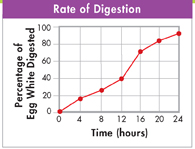Analyzing Data
Protein Digestion
A scientist performed an experiment to determine the amount of time needed for a certain carnivorous animal to digest animal protein. He placed pieces of hard-boiled egg white (an animal protein) in a test tube containing hydrochloric acid, water, and the enzyme pepsin, which digests protein. The graph shows the rate at which the egg white was “digested” over a 24-hour period.
Interpret Graphs Describe the trend in the amount of protein digested over time.
Analyze Data About how many hours did it take for half of the protein to be digested?
Draw Conclusions How would you expect the rate of meat digestion to differ in an animal whose digestive tract had less of the enzyme pepsin?
Processing Food
 How does digestion occur in animals?
How does digestion occur in animals?
Obtaining food is just the first step. Food must then be broken down, or digested, and absorbed to make energy and nutrients available to body tissues.  Some invertebrates break down food primarily by intracellular digestion, but many animals use extracellular digestion to break down food. A variety of digestive systems are shown in Figure 27–2.
Some invertebrates break down food primarily by intracellular digestion, but many animals use extracellular digestion to break down food. A variety of digestive systems are shown in Figure 27–2.
Intracellular Digestion Animals have evolved many ways of digesting and absorbing food. The simplest animals, such as sponges, digest food inside specialized cells that pass nutrients to other cells by diffusion. This digestive process is known as intracellular digestion.
Extracellular Digestion Most more-complex animals rely on extracellular digestion. Extracellular digestion is the process in which food is broken down outside cells in a digestive system and then absorbed.
▸ Gastrovascular Cavities Some animals have an interior body space whose tissues carry out digestive and circulatory functions. Some invertebrates, such as cnidarians, have a gastrovascular cavity with a single opening through which they both ingest food and expel wastes. Some cells lining the cavity secrete enzymes and absorb digested food. Other cells surround food particles and digest them in vacuoles. Nutrients are then transported to cells throughout the body.
▸ Digestive Tracts Many invertebrates and all vertebrates, such as birds, digest food in a tube called a digestive tract, which has two openings. Food moves in one direction, entering the body through the mouth. Wastes leave through the anus.
Table of Contents
- Formulas and Equations
- Applying Formulas and Equations
- Mean, Median, and Mode
- Estimation
- Using Measurements in Calculations
- Effects of Measurement Errors
- Accuracy
- Precision
- Comparing Accuracy and Precision
- Significant Figures
- Calculating With Significant Figures
- Scientific Notation
- Calculating With Scientific Notation
- Dimensional Analysis
- Applying Dimensional Analysis






